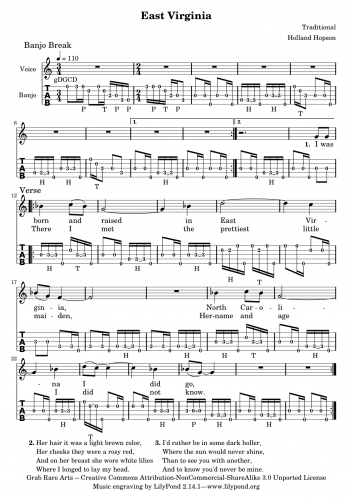
Each year since 2008 I’ve looked forward to Shawn Feeney‘s latest jack-o-lantern memorial to a recently departed musician. This year’s exquisitely carved pumpkin honors Pete Seeger.
Tag Archives: Pete Seeger
East Virginia
This month’s score from Post & Beam is East Virginia.
Download the score as a pdf file: east-virginia.pdf
Download the score as a Lilypond .ly file: east-virginia.ly

Notes on East Virginia
- The banjo break at the beginning comes almost directly from Pete Seeger’s How to Play the 5-String Banjo. I worked out the banjo part in the verse by ear, following the melody and drawing inspiration from Buell Kazee’s recording on the Anthology of American Folk Music.
- The electronics part uses multiple looping delays to create a rhythmic texture from the banjo. The timing for each delay line is based on the time between consecutive instances of a given note played by the banjo. One delay line changes every time the computer hears the note g , another changes when the computer hears f, another for b-flat, etc.
- The tablature above more accurately represents how I’d play the tune on a fretted banjo. When I play the fretless banjo, as on the recording, I throw in more slides on the 3rd and 4th strings.
Mike Seeger Gone to the New Lost City
I just heard the news that old-time musician Mike Seeger died on Friday night. Mike was the son of folklorist Charles Seeger and composer Ruth Crawford-Seeger. His other siblings were Penny, Peggy and half-brother Pete Seeger (who recently celebrated his 90th birthday and seems to be going strong). Quite a lineage for a musician, and Mike certainly made the best of it. He was a founding member of the New Lost City Ramblers along with John Cohen (see here) and Tom Paley. I think their work in the 1960s represents some of the best of the folk revival movement.
Seeger’s solo work serves as a catalog of old-time banjo styles while also demonstrating his mastery of lesser-known folk instruments such as the quills and the mouth harp. I’m particularly fond of his recordings Southern Banjo Sounds (1998) and True Vine (2003), both released on Smithsonian Folkways.
